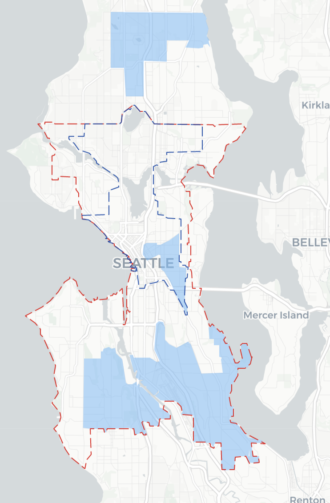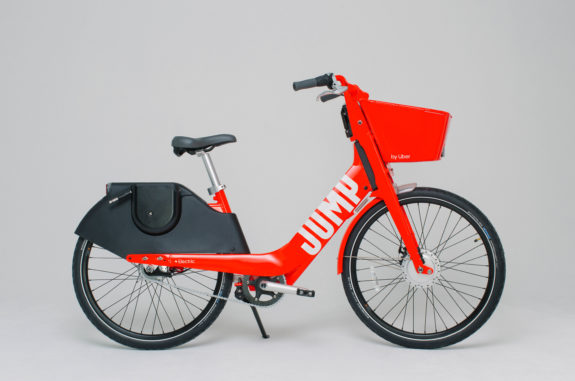
Following a Seattle Times story critical of the company’s limited service area, JUMP has expanded to include all of Southeast and West Seattle.
Though the Times story headline says that JUMP has been charging people $25 for parking outside the service area, the company says it has not actually charged the fee to anyone yet. Instead they have issued warnings.
As we reported when the bright red bikes launched in November, their initial service area was limited because they only had 300 bikes. But as they grew they would expand the area. Their permit allows up to 6,666 bikes, though the company has not yet launched the bulk of them.
They will expand again in coming months to include the entire city limits, the Uber-owned company said in a statement today. They also announced that 2,000 bikes are on the way in coming weeks to shore up supply in the newly expanded service area. And they are bringing their newly redesigned bikes, which will have a much less bulky lock compared to the current square metal locks. Users will also be able to unlock them by scanning a QR code, similar to Lime’s bikes.

And to encourage ridership during the upcoming traffic crunch downtown, JUMP is waiving the $1 unlock fees through February 15. So you just pay 10¢ per minute.
Seattle Bike Blog readers were immediately critical of the limited service area in the company’s initial launch. Even though I understand the desire not to have a limited number of bikes spread to far apart, it was problematic to include neighborhoods all the way to Green Lake in the north but stop at Mount Baker Station in the south. Columbia City is closer to downtown than Green Lake, for example.
One lesson learned from the July 2017 launch of Spin and Lime was that it was so much simpler to just include the entire city limits in the service area, even if initial bike distribution was focused downtown. Many of the city’s pilot permit rules were based around trying to encourage companies to serve more of the city because the permit authors assumed companies would want to focus service in dense and often wealthier areas. But from day one both companies served the whole city, which was something of a surprise at the time. Allowing the whole city made it much easier for users to understand and immediately allowed any city resident to access their neighborhood using the bikes. And they did.
Limiting the service area feels a bit like overthinking one problem (bike density) and creating another bigger one in the process. It doesn’t feel good for a potential user to download the app only to find out that their home is excluded. And, of course, serving Green Lake before Columbia City sends the message that whiter and wealthier north Seattle neighborhoods are more important.
So it’s good to see the service area expand, and more bikes in service will help them compete with Lime’s ubiquitous green bikes.
Here’s the statement from JUMP:
Uber today announced the expansion of its JUMP bike service area in Seattle and an increase in the number of JUMP bikes in its Seattle network. Seattle is one of the first cities to receive JUMP’s next generation bikes, which feature integrated cable locks and a QR code unlocking mechanism. Roughly 2,000 new bikes will be phased into the Seattle network in the coming weeks.
“The initial reception of our bikes in Seattle has been very positive among riders, so we’re excited to expand access. It’s something we’ve been pushing hard to do since launching in November,” said Nathan Hambley, a spokesperson for Uber in Seattle. “We hope the expanded service area and additional bikes, along with the promotions we’re currently running, help people get around Seattle during the Squeeze.”
In December, Uber announced it would offer $2.75 off Uber trips to and from select transit hubs through Feb. 15 along with waving the $1 unlock fees on JUMP bikes to help people avoid driving downtown alone while SR 99 is closed along the waterfront.
Seattle’s initial JUMP service area was limited to a zone near the downtown core due to bike supply limitations, although it was drawn to include the entire Central District Equity Area as defined in the Seattle Department of Transportation’s 2018-2019 Free Floating Bike Share Program Permit Requirements (see Appendix D).
“We have met the bike availability targets in the Equity Focus Area boundaries defined in the permit requirements even in our initial service area since launch, and we will of course continue to adhere to those requirements in our expanded service area,” added Hambley. “As we wrote in our permit application, we believe bike sharing can help make cities smaller by connecting neighborhoods and making it easier for residents to travel, no matter where they live or where we have to go.”
In the coming months, JUMP will expand its service area again to include the entire City of Seattle.
In order to encourage riders to leave bikes inside the service area, JUMP provides notice in-app and on its website of a $25 fee for locking the bike outside the system area or bike zone. Although JUMP has issued warnings, no Seattle customers have been charged the $25 fee for ending trips outside the initial service area.










Comments
9 responses to “JUMP expands service to SE and West Seattle following criticism, announces 2K new bikes”
What’s the shaded blue area supposed to represent?
Seattle’s designated equity areas. Bikeshare companies are required to include at least one of the areas at launch. This according to Erica C. Barnett.
In addition to SE Seattle, the new expanded service area now includes new UW Link Station, so folks in and near the U-district can finally start using the Jump bikes to ride the Burke-Gilman to/from Link.
It’s still not the whole city, but it’s a definitely improvement.
Of course, just as trips don’t arbitrarily stop at the city limits, bike share shouldn’t either. Next steps are to start adding the neighboring cities, piece by piece, until the entire region is covered. Obvious places to start would be the trail corridors – the Burke-Gilman, Sammamish River, and Interurban.
They have a ways to go before covering the city. Current maps shows their boundary at NE 65TH Street, leaving a significant destination like Magnuson Park
tantalizingly beyond their boundary and subject to their 25 dollar fine.
And, of course, serving Green Lake before Columbia City sends the message that whiter and wealthier north Seattle neighborhoods are more important.
Or that the wealthy, north Seattle neighborhoods are more likely to spend more on e-bikes and grow the Jump business. Like or not, Uber is a for-profit corporation. Their one and only goal is to generate profit for their investors and shareholders. They don’t give a crap about social justice, people or bicycle rights, beyond what is necessary to generate profit of course.
This is Uber we’re talking about.
If you look at a population density map, a topographic map, and the major bike paths in the area, the original plan was quite reasonable. My guess is they looked at biking data as well, and then drew up the maps accordingly.
It included the Central Area, so I don’t buy the social justice issue. If it was trying to pick up mostly well to do white people, then it would have stretched to the east to Madison Park, Madrona, and the wealthy areas of Mount Baker. The original plan was flawed, but like the original Pronto boundaries, I don’t think it was flawed for social justice reasons. It was just too small. It makes sense to include areas to the north of ship canal, as well as the Central Area (something Pronto skipped). But it should include the UW, as well as all of Ballard. The former was probably because they needed to work it out with the UW, and the latter was probably just an oversight. It also makes sense to extend into Rainier Valley, although my guess is they found relatively low bike use rates, because the area lacks good bike paths.
Now I think they have overcompensated. Extending into all of West Seattle (including lots of wealthy areas) seems like a big money loser. They will have to do a lot of shuffling, as folks ride the bike down from places like the Junction. I know they are electric, but unless they have a lot more bikes, I don’t see someone making a trip the opposite direction — most of West Seattle is just too sparsely populated.
Meanwhile, they don’t include Madrona and Madison Park, although at least they have moved the line well to the east of MLK. But the big gap is in the north end now. Places like Lake City and Northgate, which have a lot more density than West Seattle, get nothing. These are places that are similar to White Center (in terms of income) yet don’t have service yet. It is still a weird map, but at least it is bigger.
Agree 100%. The original layout didn’t cover a lot of the city and was pretty useless for my own purposes, but it made sense (to me) as getting the most bang for your bikes (300 is a pretty paltry count). I’m no big Uber fan, but for all the reasons you pointed out, the criticism of their zoning seems a bit like crying social justice wolf.
I’m very confused by the decision behind the new boundaries. Bikeshares don’t magically make bike trails appear. Assuming you want more equity zone inclusion, why on earth would you leave out the Northgate+ zone–already connected via the Interurban North–in favor of the very distant, unconnected Southern zones? It’s only a few blocks away from the top of the Greenlake zone boundary!
Maybe their plan is to leave the north to Lime in an attempt to be the dominant bikeshare of South Seattle.
>> It doesn’t feel good for a potential user to download the app only to find out that their home is excluded.
Wouldn’t you just look at the map, which is on the main webpage: https://jump.com/cities/seattle/. It took me all of ten seconds to see the boundaries.
Lime bike doesn’t do that. You have to download the app, give them your credit card info, then find out whether they have any bikes in your area. If there is a way to get access to the map before downloading the app, then I haven’t seen it. Lime seems mainly interested in gathering information about its users (which is why you have to download the app, even if you are just mildly interested) which seems like it is bound to fail, as so many dot com type schemes have.
[…] jump: Jump expanded its private bikeshare service area and will add 2,000 bikes to streets in […]